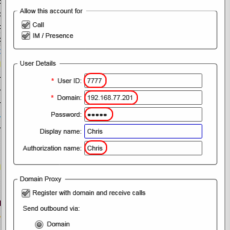Here is three ways of configuring Call Detail Records(CDR) on Cisco Unified Call Manager Express(CUCME)
1. FTP
The Cisco Unified Call Manager Express(CUCME) utilized the FTP protocol to deliver Call Detail Records to a FTP server. The FTP feature(Disabled by default) must be activated and configured to deliever call records to a FTP server.
The following steps to enable and configure FTP way of sending CDRs.
CME_CDR(config)# gw-accounting file : To enable file accounting (FTP Delivery)
CME_CDR(config-gw-accounting-file)# primary ftp x.x.x.x/path/filename username CISCO password CISCO | ifs device:filename : To specify the primary location for storing CDRs generated for file accounting
CME_CDR(config-gw-accounting-file)# secondary ftp x.x.x.x/path/filename username CISCO password CISCO | ifs device:filename : To specify the secondary location for storing CDRs generated for file accounting
CME_CDR(config-gw-accounting-file)# maximum retry-count 3 : To specify the maximum number of times the router attempts to connect to the primary file device before switching to the secondary device.
CME_CDR(config-gw-accounting-file)# maximum buffer-size 15 : (Kbytes)
CME_CDR(config-gw-accounting-file)# maximum fileclose-timer 300 : (minutes) : To specify the maximum time in minutes for writing records to an accounting file before closing it and creating a new file (default 1440 – 24 hours). This timer must be set to at least 5 minutes greater than the flush timer
CME_CDR(config-gw-accounting-file)# maximum cdrflush-timer 245 (minutes) : To specify the maximum time in minutes to hold call records in the buffer before appending the records to the accounting file (default is 60). This timer must be set to at least 5 minutes less than the fileclose timer
CME_CDR(config-gw-accounting-file)# cdr-format compact : To specify the format of the CDRs generated fo file accounting (default is detailed)
CME_CDR(config)# acct-template {template-name | callhistory-detail} : To specify the voice attributes to collect
To initiate file processes manually.
CME_CDR# file-acct flush {with-close | without-close}
CME_CDR# file-acct reset
Troubleshooting File Accounting.
CME_CDR# debug voip fileacct
CME_CDR# debug voip dump-file-acct
2. Syslog server
Monitoring IP Phones Using Cisco Unified CME Syslog Messages
Cisco Unified CME 3.0 introduced type 6 syslog messages, as shown in the following example, for IP phone registration and deregistration events. These syslog messages are useful for a central NMS to manage Cisco Unified CME systems and IP phones.
CME_CDR(config)# service timestamps log datetime msec localtime : To ensure CDRs are time stamped with an accurate value.
CME_CDR(config)# aaa new-model : To Enable AAA
CME_CDR(config)# aaa authentication login default none
CME_CDR(config)# aaa accounting connection H.323 start-stop radius : To generate the H.323 call start/stop CDRs.
CME_CDR(config)# gw-accounting syslog : To send the H.323 CDRs to the syslog server
CME_CDR(config)# logging 10.10.10.1 : Syslog server (It can be multiple servers)
To synchronize your Cisco Unified CME system to an external NTP server, use the following:
CME_CDR(config)# ntp server ip-address
!!! ip address – IP address of the time server providing the clock synchronization
3. RADIUS
4. Tips and troubleshooting
– Show commands
show voice statistics memory-usage csr
– Debug commands
debug voip fileacct
debug voip dump-file-acct




 The www.ipBalance.com runs by a volunteer group with IT professionals and experts at least over 25 years of experience developing and troubleshooting IT in general. ipBalance.com is a free online resource that offers IT tutorials, tools, product reviews, and other resources to help you and your need.
The www.ipBalance.com runs by a volunteer group with IT professionals and experts at least over 25 years of experience developing and troubleshooting IT in general. ipBalance.com is a free online resource that offers IT tutorials, tools, product reviews, and other resources to help you and your need.

![[Splunk] – Basic search fields and commands logo_splunk.png](https://ipbalance.com/wp-content/uploads/2009/06/logo_splunk-100x80.png)
